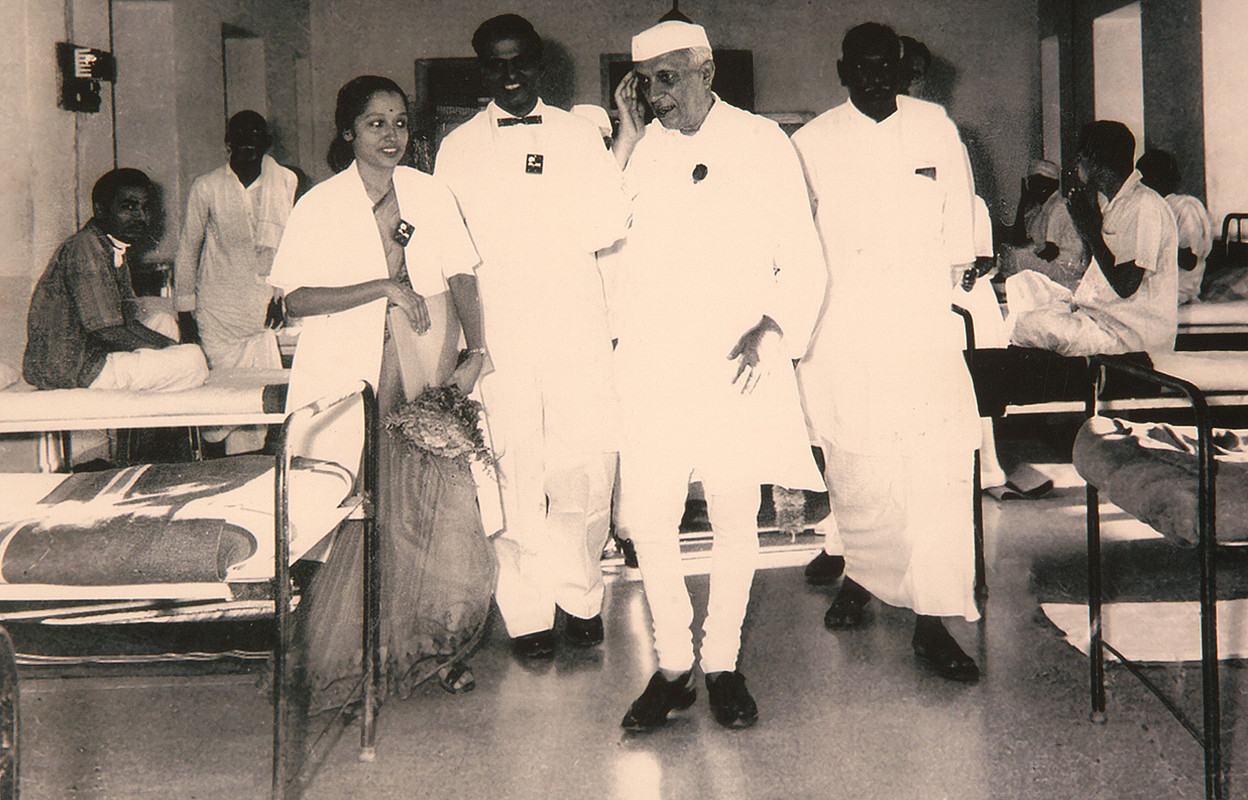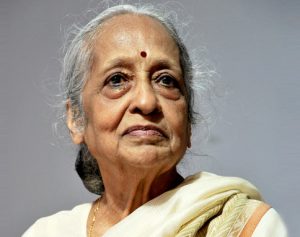
Dr V Shantha: A phenomenal doctor who dedicated her life to cancer cure
Dr V Shantha, Padma Vibhushan and Magsaysay awardee, passed away on early Tuesday morning (January 19) at the age of 93. “She was working till 5 pm a day before,” said Susheela, her sister, adding, “She was taken to the hospital when she felt an unease in the night and after very little struggle she breathed her last.”

Dr V Shantha, Padma Vibhushan and Magsaysay awardee, passed away on early Tuesday morning (January 19) at the age of 93. “She was working till 5 pm a day before,” said Susheela, her sister, adding, “She was taken to the hospital when she felt an unease in the night and after very little struggle she breathed her last.”
Dr Shantha was a phenomenal lady who dedicated her life for the betterment of cancer patients. “When the sick approach the gates of the institute, full of fear, weak in body and spirit, there is only one approach. One has to become part of them,” Dr V Shantha once famously said.
So the one thing Dr Shantha thought she could do was to build a strong network of volunteers. She invited those who had been cured of cancer to volunteer at The Cancer Institute at Adyar in Chennai, to help new patients. She also sought help from recovered patients, who could speak different languages since many of the patients came from villages in Andhra Pradesh and some even from as far as Assam and Arunachal Pradesh.

Dr V Shantha met Dr Krishnamurthy at the newly formed cancer unit at the Madras Medical College in 1950 while he was attending to some cancer patients. It was her first posting as a house surgeon and Dr Krishnamurthy talked endlessly about the need for a cancer specialty institute and how his mother, the social reformer and iconic lady Dr Muthualakshmi Reddy, was striving for it. Dr Shantha was very impressed with Dr Krishnamurthy’s values, principles and the phenomenal medical knowledge that he had. “Dr Krishnamurthy was an idealist and visionary beyond compare,” Dr Shantha had said. So she decided to switch from obstetrics and gynaecology to oncology.
In 1952, she attended the foundation laying ceremony of the cancer institute, inaugurated by the then Prime Minister Jawaharlal Nehru. In 1955, she moved into the hospital and has been a pillar of strength for the institute till she passed away on January 19, 2021. She was a beloved student of Dr Muthulakshmi Reddy whom she called ‘Amma’ and a trusted partner to Dr Krishnamurthy, whom she helped build the cancer institute into an iconic institute that today has presence all over Asia. (Dr Krishnamurthy, the second son of Dr Muthulakshmi Reddy, was among the early doctors who specialised in cancer treatment. He helped his mother establish the institute and became its chairman after her death in 1968 till his own demise in 2010.)
Food for patients and caregivers was cooked at Dr Muthulakshmi Reddy’s house and sent to the institute. It was a Sevagram (Mahatma Gandhi’s ashram in Wardha district of Maharashtra) type hut that the institute began with and had only two medical professionals to treat patients.
“The struggle that Dr Muthulakshmi Reddy had to undergo in getting a piece of land for the institute and to get it going is phenomenal,” said Dr Shantha once. “She was laughed at in the beginning. Cancer was considered a ‘karma vyadhi’ (a disease caused because of your bad deeds of the past). She was asked why a cancer institute when we all know that people just die from it. It was a herculean task to convince the government, the corporate bodies, professionals and the public to look at cancer as a curable and preventable disease,” Dr Shantha had said.
Dr Muthulakshmi Reddy collected ₹1 lakh from Women’s Indian Association volunteers to start the institute. DMS (Directorate of Medical Sciences) had declared the institute economically unviable. “The most painful and frustrating thing was the divide between the government and non-government organizations. A non-government organization is never accepted as a co-worker or as a partner, but quite often as a competitor. Initially, we were told things like “close the shop”, “justify the need for a library” etc. However, such comments only proved how ignorant people were then and their mindset. In fact, we have been pioneers in many areas, but most of our efforts have gone unrecognized. Today, however, there is a growing understanding of the services and the institute itself. There have been people who have recognized our work and helped us, both nationally and internationally, and we are very grateful to them,” said the Magsaysay award winner.
“My story is as much of the institute as the Women’s Indian Association. It is always a team,” she said. “My family had Nobel laureates like C V Raman and S Chandrasekhar and exceptionally gifted musicians, who played a major role in molding my mind and character in the formative years. Expectedly, I was supposed to be something different,” Dr Shantha said.
Those days women took up teaching or nursing and they taking up medicine or legal profession was a rarity. “I wanted to do something that gave me independence and respect in society,” she had said.
“I was a loner in college. I never attended college functions but was very interested in classic English literature and devoured books when had the time. I had very few friends.”
It was when she was in 8th grade that she decided she wanted to become a doctor. Her mother encouraged her as she herself wanted to be a nurse, but could not.
“To give always and not to take,” was a policy that her family and Dr Muthulakshmi Reddy, the founder of the cancer institute, had imbibed in her.
“Everything for every patient was Dr Reddy’s motto. No one should be deprived of treatment for lack of financial resources,” Dr Shantha said.
In 1956, on Christmas day, the Atomic Energy Agency donated the cancer institute its first Cobalt- 60 unit Eldorado. “People began to take us seriously. They were wondering how we, an institute that operated from Sewagram type huts, got chosen to receive the Cobalt-60 unit when even the government hospitals did not have them. We rejoiced in becoming suddenly famous!” chuckled Dr Shantha.
“The one thing I learnt from Dr Muthulakshmi Reddy was to express myself without any fear.” The taste of it one saw at the dignified and strong presentation she made on behalf of NGOs when Prime Minister Narendra Modi visited the institute a few years ago.
We have moved from an era of incurability to curability. Today, two-third of cancers can be prevented or cured. However, the cancer care institute currently cures only one-thirds of the patient because patients come to them at an advanced stage. This means that 60 percent of cancers are preventable or have methods for early detection. And if they are detected early, they are curable. The other 40 percent still evades us. We hope that this too will change over the coming years.
“Dr Shantha had a phenomenal memory” said Shantha Guhan, the wife of late economist S Guhan who succumbed to cancer. “She has been very kind to me and others who were caring for the family members with cancer. She could remember any patient’s medical history without consulting files and really went out to look after the poor patients.”
“Dr Shantha was a symbol of service to humanity. Her life was a message of compassion, empathy and determination. She was a legend in her lifetime and a saviour of the poor,” said Sugalchand Jain, a donor to the institute.
Dr Shantha believed that sustainability is the greatest challenge. “We as a nation need to do a lot more towards early detection and creation of awareness about prevention of cancer. Late detection of the disease still constitutes over 60% to 70% of the cases. Further, we need to make diagnosis and treatment accessible. A big chunk of patients still cannot reach a care centre that can provide them treatment, specialty care or even standard care. An insurance for cancer is becoming increasingly essential. We need to do this while providing affordable care, because with the increase in technology the cost of treatment too is progressively rising,” she had said.
Palliative care is again something that a very small percentage of people are entitled to in this country and this needs to change, Dr Shantha used to say. Lastly, while we continue working on these areas, we need to accelerate and continue our research practices to keep up with the latest advances so that our patients get the best care.
Also read: Chennai’s cancer institute chairperson Dr Shantha dies at 93
Medicine was considered an art — an art of listening, humanity and compassion. As knowledge increased along with the proliferation of sophisticated technology, the art of listening diminished and is gradually disappearing. Medicine, which was an art and then a science, slowly reversed to being all about the science and the art component now forms an unequal partner. Technology is the new art of every doctor. We need to realize that a doctor-patient relationship is unique – it is sacred and one of confidence, trust and confidentiality.
That trust and confidence built up over the years has realized today as we see droves of patients, nurses, doctors and general public quietly pay tribute to a phenomenal woman of quiet dignity and of a life spent in service.
(The author is founder and managing trustee of The Aseema Trust, a nonprofit organisation for linking traditional performing arts and education and Mahatma Gandhi and education)


